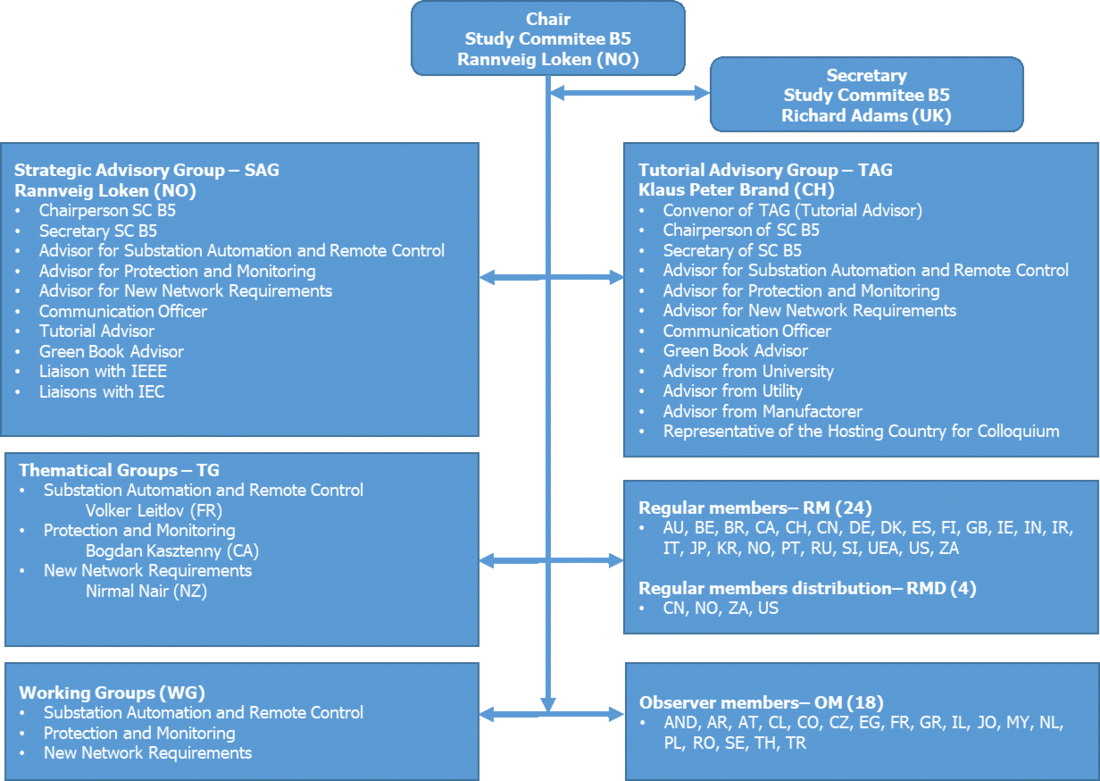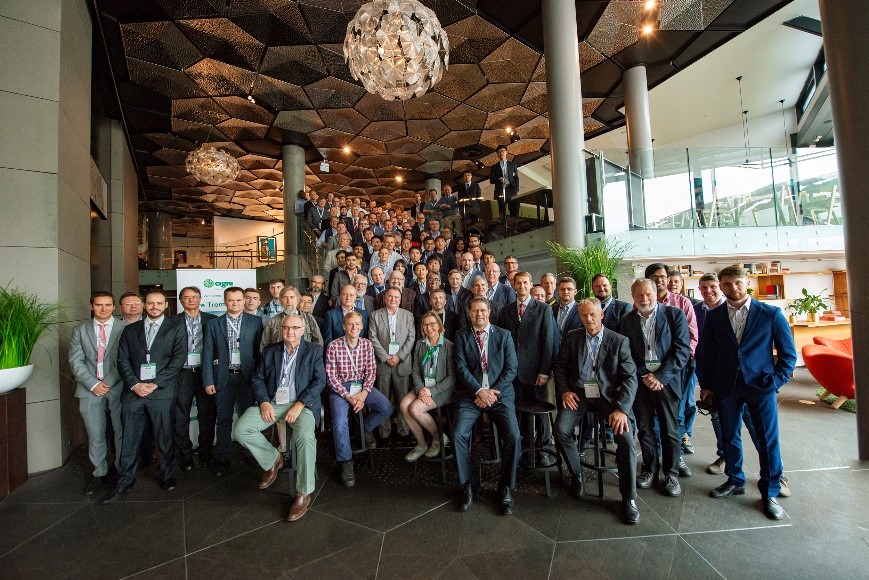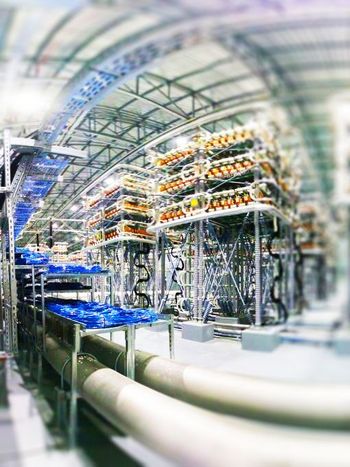Protection and automation
by Rannveig S. J. Løken, Chair & Richard Adams, Secretary
Introduction
This report reviews the organization, processes, results and activities of Study Committee B5 (SC B5) in the year 2019. CIGRE Study Committee B5 - Protection and Automation, or SC B5 for short, focuses on Protection, Control, Monitoring and Metering and aims to cover the whole Power system, end-to-end related to this topic, from transmission systems, to distribution systems, including generation and HVDC systems.
Objectives
Study Committee B5 promotes the synthesis and dissemination of state of the art practices, recommendations and information about Power System Protection and Automation on a worldwide basis. Its main activities cover the principles, design, application and management of power system protection, substation control, automation, monitoring, recording and metering, as well as the associated internal and external communications and interfacing for remote control and monitoring. SC B5 aims to be an independent analyzer of different solutions and provider of high quality unbiased publications and contributions to the electrical supply industry. Members of SC B5 from all regions of the world provide a global perspective on the issues and challenges facing the protection of electrical power systems, aiming top and medium management and technical staff of utilities, suppliers and consultants, universities and research centers, including young and experienced engineers and standardization organizations.
Organization
To attain its objectives, SC B5 is organized as shown on Picture 1. Five Advisory Groups support the decisions of the Chair and Secretary: the Strategic Advisory Group (SAG), the Tutorial Advisory Group (TAG), and three Strategic Thematic Groups (TG) specialized in Substation and Automation, Protection and Monitoring, and New Network Requirements, respectively. The Study Committee is formed by twenty-four regular country Members, four additional regular Members from distribution, eighteen observer Members, several Working Groups (WG) and Joint Working Groups with other Study Committees and organizations.

SC B5 Organization
It is the mission of the Strategic Advisory Group (SAG) to advise the chair about strategic issues related to the activities of the committee, helping in the elaboration of the SC Strategic Plan. The Tutorial Advisory Group (TAG) advises about the organization and promotion of tutorial activities of the committee, selecting the topics for the tutorials, the presentation material, appointment of lecturers and monitoring their quality. The three permanent Strategic Thematic Groups (TG) organize the proposals of new Working Groups and Preferential Subjects related to Substation Automation, Protection and Monitoring, and New Network Requirements for discussion and voting during SC B5 meetings and select reviewers of the final reports of the Working Groups.
Table 1, 2 and 3 shows the WGs that were active at the end of 2019, organized by Strategic Thematic Groups (TG), with their respective conveners.
TG 51 - Substation automation and remote control
| WG B5.50 | IEC 61850 Based Substation Automation Systems – Users Expectations and Stakeholders Interactions, P. Lindblad (FI) |
| WG B5.56 | Optimization of Protection Automation and Control Systems,P. Kreutzer (CH) |
| WG B5.59 | Requirements for Near-Process Intelligent Electronic Devices, X. Lei (CN) |
| WG B5.60 | Protection, Automation and Control Architectures with Functionality Independent of Hardware, A. Voloshin (RU) |
| WG B5.63 | Protection, Automation and Control System Asset Management,M. Petrini (IT) |
| WG B5.66 | Cybersecurity requirements for PACS and the resilience of PAC architectures, D. Holstein (US) |
| WG B5.68 | Optimisation of the IEC 61850 Protection, Automation and Control Systems (PACS) engineering process and tools, C. Bloch (FR) |
| WG B5.69 | Experience gained and Recommendations for Implementation of Process Bus in Protection, Automation and Control Systems (PACS), A. Apostolov (US) |
TG 52 - Protection and Monitoring
| WG B5.47 | Network Protection Performance Audits, P. Watson (GB) |
| WG B5.48 | Protection for developing network with limited fault current capability of generation, T. Bi (CN) |
| WG B5.52 | Analysis and comparison of fault location systems in AC power networks, A. Montenegro (SE) |
| WG B5.55 | Application of Travelling Wave Technology for Protection and Automation, P. Crossley (GB) |
| WG B5.57 | New challenges for frequency protection, V. Terzija (GB) |
| WG B5.58 | Faster protection and network automation systems: implications and requirements, A. Podshivalin (RU) |
| WG B5.65 | Enhancing Protection System Performance by Optimising the Response of Inverter-Based Sources, F. Filho (BR) |
| JWG B5/A4/C4.37 | System conditions for and the probability of out-of-phase,A. Janssen (NL) |
| JWG C4/B5.41 | Challenges with series compensation application in power systems when overcompensating lines, L. Haarla (FI) |
TG 53 - New Network Requirements
| WG B5.41 | Investigation of possibilities to improve metering systems for billing purposes in substations, R. Adams (GB) |
| WG B5.54 | P&A Issues of Islanded Systems during System Restoration/Black Start, N. Nair (NZ) |
| WG B5.62 | Life Cycle Testing of Synchrophasor Based Systems used for Protection, Monitoring and Control, M. Kezunovic (US) |
| WG B5.64 | Methods for Specification of Functional Requirements of Protection, Automation, and Control, I. Patriota (BR) |
| WG B5.70 | Reliability of Protection Automation and Control System (PACS) of power systems – Evaluation Methods and Comparison of Architectures, A. Voloshin (RU) |
| JWG B5.C4.61 | Impact of Low Inertia Network on Protection and Control, R. Zhang (GB) |
| JWG B5.D2.67 | Time synchronization for protection devices, J. Yubo (CN) |

Learn more about CIGRE active Working Groups / Call for experts
Technical activities
In 2019, three new WGs were suggested during the SC B5 Colloquium in Tromsø, Norway, and will be approved by the Technical Council Chair in 2020, to address current issues related to protection and automation of power systems:
-
WG B5.71 – Protection, Automation and Control Systems (PACS) communication requirements for inter-substation and wide area applications
The general aim of the WG is to perform assessment of communication requirements and constraints related to existing and new applications. It will also investigate the use of packet-based communication technology for PACS. The WG will analyse migration strategies to packet-based communication technology and support of Time Synchronization. They will also investigate the current state of applications using inter-substation communications, user expectations and assessment of industry road map.
- WG B5.72 – modelling, assessment, and mitigation of protection performance issues caused by power plants during dynamic grid events
The general aim of the WG is to review past disturbances and possible future events where protection systems may respond in an undesired or unexpected way to dynamic grid events. Perform a survey related to existing utility practices for modeling or considering protection behaviour in dynamic studies. The WG will asses which protection functions can be modeled in RMS transient stability and EMT simulation tools to identify credible protection issues and perform protection function Modelling. They will find methods for identifying, reporting, and visualising undesired protection operations in RMS and EMT studies. The WG will also investigate methods for mitigating the risk of undesired protection response to dynamic system events.
- WG B5.73 – Experiences and trends related to protection automation and control systems functional integration
The aim of the WG will be to investigate the state of the art and perspectives of integration of automation, control, monitoring, metering and protection functions and study aspects related to the virtualisation of functions, configuration and interfacing of integrated functions and subfunctions. They will study aspects related to the transition to integrated architectures for substation level functions and investigate technical limits and other constraints for functional integration. In addition they will focus on impact of Functional Integration on asset management of the PACS, Cyber Security aspects related to Functional Integration and report experience feedback.
Two WG's were disbanded by the chair in 2019 with the Technical Brochure sent for publication:
The Technical Brochure 768 – SC B5 is entitled “Protection Requirements on Transient Response of Digital Acquisition Chain”. The Brochure covers a number of aspects related to the required transient response of a complete Digital Acquisition Chain as this became an important issue with the development of IEC 61850 based substations using Stand Alone Merging Units (SAMU) and / or Non-Conventional Instrument Transformers (NCIT) and featuring IEC 61850-9-2 process bus together with Algorithmic Digital Signal Processing for Protection, Automation and Control functionality. The most important influencing factors for their reliable operation have been examined and presented as the main requirements to different elements of the complete Digital Acquisition Chain.
Additionally, the Technical Brochure 760 – SC B5, discusses the wide spread development and implementation of IEC 61850 based Substation Protection, Automation and Control Systems (SPACS) using predominantly Goose messages and client/server communications has raised the awareness of the industry regarding the benefits of communication based systems. At the same time, the last years have seen a significant change in the availability of stand-alone and embedded Non-Conventional Instrument Transformers (NCIT) with IEC 61850 sampled values interfaces. For this reason, the testing of fully digital functional chains has become an important issue with the deployment of IEC 61850-based substations using Stand Alone Merging Units (SAMU), and/or NCIT and featuring both station bus (IEC 61850-8-1) and process bus (IEC 61850-9-2). This Brochure covers all test related aspects of a fully digital SPACS and equipment, including NCIT/SAMU Certification tests, SPACS level Interoperability tests, Factory Acceptance Tests, Commissioning and Site Acceptance Tests and Maintenance tests after commissioning
The best papers from the SC B5 Colloquium in Tromsø, Norway 2019 were:
- B5#117 Use of PMU data for locating faults and mitigating cascading outage, M. Kezunovic (USA)
- B5#213 Redundant secure timing sources and timing distribution to digital power protection and control applications, H. Hauglin (Norway)
- B5#306 Using Wavelength Division Multiplexing for Protection Applications, V. Skendzic (USA)
They will be published in CIGRE Science & Engineering (CSE).
The best papers from the CIGRE Symposium, Chengdu, China 2019 from SC B5 was paper #072 Unwanted blocking of differential protection during converter transformer internal faults by Y. ZHAO, P. CROSSLEY (UK). This paper will be published in CIGRE Science & Engineering (CSE).
Tutorials
To promote the discussion of current issues related to protection and automation, and as part of its mission to help the dissemination of knowledge about protection and automation, in 2019 the following tutorials were presented by SC B5 Members;
Tutorial during SC B5 Colloquium in Tromsø, Norway, June 2019:
- Impact of Geomagnetic Storms on Protection
- Physical Phenomena by Pål Brekke (NO)
- Impact on Power Systems and Mitigation Techniques by Stein Ingebrigtsen (NO)
- Impact on Instrument Transformers and Protection by Normann Fischer (US)
- Principles and Applications of PTP by Roman Graf (CH)
Tutorial during Symposium in Chengdu, China, September 2019:
- Test Strategy for Protection, Automation and Control (PAC) Functions in a Fully Digital Substation Based on IEC 61850 Applications by Dr Alexander Apostolov (US)
Keynote speeches
To disseminate the activities of CIGRE, Members from SC B5 have participated and presented Keynote speeches during IEEE APAP (Advanced Power system Automation and Protection), XiAn, China, October 2019:
- Progress of Power Science and Technology by Mark Adamiak (US)
- To open a new era for automation and protection of power system : Deep Learning by Seung Jae Lee (KR)
- System Protection Technology to Prevent Cascading Faults by Xinzhou Dong (CN)
- News from Study Committee B5 – Protection and Automation, Leveraging PMU data for better PAC system by Rannveig S. J. Løken (NO)
- Time and Its Role in Protection, Automation and Control Systems (PACS) by Dr Alexander Apostolov (US)
- Protection of Future Power Systems by Campell Booth (UK)
- Experience in protective relaying for networks with high penetration of renewable energy – modelling and testing by Marjan Popov (NL)
Colloquium and Discussion sessions

SC B5 Colloquium in Tromsø, Norway, June 2019
The main forum for technical debates about Protection and Automation in 2019 was SC B5 annual Colloquium in Tromsø, Norway, see Picture 2 – SC B5 Colloquium in Tromsø, Norway, June 2019. SC B5 conducted three discussion sessions during this Colloquium and the papers submitted addressed topics related to the following Preferential Subjects:
PS1 - Leveraging PMU data for better Protection, Automation and Control Systems
Topics selected for discussion include Use of PMU data to improve system models and to monitor analogue inputs, Adaptive protection concepts utilizing PMU data, Wide area schemes, novel backup protection, power swing protection, and synchronizing schemes based on PMU data, Improvements in PACS commissioning and post‐event analysis using PMU data. The session was reported by Rafael Fernandes (BR)
PS2 - Time in Protection Applications – Time sources and distribution Methods
Topics selected for discussion include Sources and distribution of time references in PACS and Wide Area Systems and the related accuracy, Engineering of time synchronisation and time reference distribution for IEC 61850 process bus based protection and control applications, Commissioning and testing of time reference sources and distribution means, Expected behaviour of PACS functions in case of loss and recovery of time synchronization. The session was reported by Dr. Yubo Yuan (CN).
PS3 - Future technologies for inter-substation communication, Migrating Digital Teleprotection Channels to Packet-Based Networks
Topics selected for discussion include Digital Teleprotection Channels to Packet-Based Networks, Migration of Serial Teleprotection Channels to Packet‐Based Networks and best practices for specifying, testing, commissioning and monitoring, Specification of channel or network performance, data transmission and management of constraints for PACS, Data Segregation including use of virtual networks and WDM (Wavelength‐Division, Multiplexing) for PACS and performance analysis methods, Substitution of serial interface: Technologies, topologies, constraints and experience feedback. The session was reported by Dr. Fred Steinhauser (AT)
For 2020, SC B5 will take part in the e-Session in "Paris, France", and papers submitted on the following Preferential Subjects will be presented:
PS1 - Human aspects in Protection, Automation and Control (PACS)
Topics selected for discussion include Causes, types, stages of occurrence and consequences of human errors, Impact of PACS complexity and degree of functional integration on human errors, Prevention of human errors including training, work authorization and peer reviews, procedures, application templates and standardization, and best practices for working with subcontractors and third parties. The session will be reported by Simon Hussey (IE).
PS2 - Communication network in Protection, Automation and control (PACS): Experience and challenges
Topics selected for discussion include Management of Redundancy in communication network for applications and Intelligent Electronic Device (IED), Data Segregation including use of virtual networks for PACS applications, Architecture of PACS communication network including Management of communication constraints. The session will be reported by John Wright (UK).
Awards
In recognition for their contribution to the activities of CIGRE, SC B5 has nominated the following recipients for awards in 2019:
CIGRE SC B5 Outstanding Service Award
The Outstanding Service Award of CIGRE Study Committee B5 - Protection and Automation is granted by the SC Chairman annually to members in recognition for outstanding participation and contribution to the activities of the Study Committee. For 2019, the award went to Iony PATRIOTA de SIQUEIRA, from BR in recognition of his contribution, commitment and dedication to the objectives of CIGRE. He is a recognized expert in power system automation, he has been the Chair of SC B5, and has also been frequent contributor to CIGRE Working Groups, as WG convenors. The award ceremony was conducted by the Chair of SC B5 during the SC B5 Colloquium in Tromsø, Norway.
Strategic Planning
The strategic plan of CIGRE Study Committee B5 – sets out the strategic technical directions to be followed by the B5 Committee over the period 2019–2028 in order to address the main objectives set by CIGRE Technical Committee.
Based on this analysis, the following technical directions were validated by SC B5 Strategic Plan for the period 2019-2028:
- Influence and Contribute towards Protection and Automation Global Expertise
- Providing Key Technical SC B5 PACS information to Executives, Regulators, Policy Makers and Technology Innovators;
- Increase brand and visibility of SC B5 PACS amongst membership, research academics, trade associations, regulators, policy makers and government;
- Developing Marketing avenues and platforms to support leading edge innovative concepts of B5;
- CIGRE B5 Africa Strategy
- Supporting CIGRE Power System of the Future Vision: SC-B5 Strategy
- Understand and influence the development of new technology and practices for all voltages and systems.
- Supporting CIGRE Peoples and Skill of Future Strategy: SC-B5 Efforts
- Engaging actively with Central Office efforts towards operation Excellence
Details about the process adopted by SC B5 and the complete result can be found in the Strategic Plan.
Conclusions
The year of 2019 was full of achievements for SC B5, a result of the voluntary work of dedicated individuals and organizations, including the secretary, advisors, conveners, special reporters, members and observers from many countries around the world. For the future, the strategic directions set by SC B5 aim to facilitate the human development and application of new technology to improve the efficiency of the engineering, design, operation and maintenance of protection and automation of electric power systems and keeping the spirit of collaboration that distinguishes CIGRE among organizations around the world.

